
| Jacket 37 — Early 2009 | Jacket 37 Contents page | Jacket Homepage | Search Jacket |
The Internet address of this page is http://jacketmagazine.com/36/r-mead-rb-brown-pam.shtml
Philip Mead
Networked Language: Culture & History in Australian Poetry
reviewed by Pam Brown
540 pp. Australian Scholarly Publishing: Homepage 9781740971973 paper
This review is about 15 printed pages long.
It is copyright © Pam Brown and Jacket magazine 2008.
See our [»»] copyright notice.
1
Poems are made (poesis) out of the solute of ordinary words, even if it is difficult to know exactly how this happens. Broadly speaking, poetics is the name we give to the fractal geometry of textual meanings.
— Philip Mead:
Introduction to Networked Language
2
Philip Mead’s Networked Language: Culture & History in Australian Poetry is a much needed, dynamic ingression in the tiny field of Australian poetics. Critical writing on poetry in Australia is incredibly scant considering the sizeable publication (and associated activities) of poetry. However, as tiresome as it is to note once more, in spite of its volume and vigour, poetry itself remains marginal to Australian culture.

Philip Mead, Melbourne, 2008
Photo by John Tranter
Paragraph 3
Practising poets need to read poetics. My own bookshelves house many books of essays on poetry by contemporary North American poets and critics, some European and some from the UK, yet relatively few books on Australian poetics. Strategically, Australian poet-editors use their introductions to infrequent anthologies to gesture towards a poetics. So, Philip Mead is working in a disappointingly small world. In his introduction Mead discusses the dearth of critical writings on poetry and, in fact, of Australian literary theory in general. He says
4
… in the Australian context the critical discourse on poetry lags seriously behind, or is out of sync with, the formal innovativeness and linguistic range of historical and contemporary poetry production. It’s as if literary theory and criticism can’t envisage ways forward. In response to this scenario, the essays that follow are experiments in the theory and practice of a kind of contextual reading, in trying to articulate some of the ways in which poetic language is networked with culture and history.
5
The phrase ‘culture and history’, from the book’s subtitle, suggests that these essays are sociologically motivated. The essays are not narrowly ‘Australian’, rather they are links, nodes or points of connectivity in a ‘networked language’, a concept perhaps influenced by the notion of Deleuze and Guattari’s rhizomatic mode of knowledge. Mead’s research and approach acknowledges the contribution to literary criticism by theorists from fields other than literature whilst noting the rare use of poetic writings within literary cultural studies. In part, he blames the use (and publication) of poetic texts for teaching purposes and, historically, the reading of these texts as part of the quest for a national identity of this so-recently white-settled country. The identity quest informed the construction of institutional curricula concerning Australian literary studies and its component courses, journals and so on. Mead speculates on how a critical discourse limited by these and other factors led to misinterpretations of some poets’ writings that he re-reads and re-contexualises here.
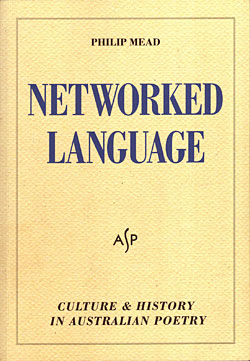
6
One of the other factors is the general perception of poetry as a ‘dead medium’, as Mead recounts one contemporary young techno-geek putting it, or ‘a kind of quaint antiquarian artistic form, a politically baleful remnant of (Bourdieu’s) aristocracy of culture … [Mead continues] one reality is that impatience with the (dead) past and its once privileged expressive forms is a characteristic of postmodern culture. Complexity needn’t involve historical depth.’
7
Here vindicating my own complaint about ‘major’ Australian anthologies in which the reader always has to trudge through what are usually the same nineteenth century poets as if modernist and contemporary poetries can’t be taken seriously unless they are authenticated by ‘history’. Something that also echoes the earlier habit (or commercial cynicism) of publishers requiring major anthologies to be tailored to educational syllabi by including the historical material in order to justify publication.
8
Reasonably however, while considering poetry’s cultural irrelevance, Mead refers to satirist Thomas Peacock’s famous early nineteenth century essay against poetry that describes poets as, among other dastardly things, ‘puling drivellers’ and ‘semi barbarians in a civilized society’ living in the past. Peacock declared that poetry writing was a childish pursuit. Mead reconsiders Shelley’s idealistic response in defence of poetry, including the old chestnut that poets are the unacknowledged legislators, as an impossible assertion in the post modern twenty-first century. Looking at Peacock’s influence, Mead concludes ‘So while poetry doesn’t seem to count for much… perhaps the truth is it never did’ and ‘Poetry may once have been a form of capital, but now?’
9
This reminds me of the US poetry publisher James Sherry’s remark, that if you take a sheet of plain white paper, perhaps it’s worth a penny, but if you write a poem on it, it’s worth nothing. It devalues.
10
Mead cites US poet and academic Christopher Nealon’s suggestion ‘that debates about the market-value (obviously nil or deficit), the use-value or surplus-value of poetry, are a dead-end in terms of the social life of a mode of creativity and that the impulse to defend poetry — an impulse shared by [Networked Language] — is the impulse to defend a mode of language that is virtually useless’. A doomed defence which leads to what Nealon calls ‘critical bewilderment’ even as it ‘risks valorizing uselessness as such’.
11
Mead refutes the negativities of ‘critical bewilderment’ and presents his essays, within the context of poetry’s ongoing indeterminate value, as complex reappraisals, re-understandings and explorations in the continuing flux of the contemporary poetic scene. The essays become enlivened arguments for poetry’s socio-linguistic effect, or impact, in a misinterpreted, disremembered, often nationalistic literary culture. Informing the text is an underlying alertness to the general survival of poetry in diverse, adaptive, regenerative and tenaciously persistent ways.
12
What kind of readings are these then? I begin with a consideration of poetry and the beginnings of cinema in Australia in the first decades of the twentieth century and end with a reading of poetry in the multicultural present.
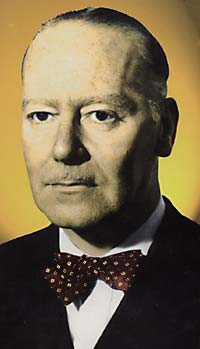
Kenneth Slessor
13
1. Ut cinema poesis, the first essay, concerns the forgotten aspect of poet Kenneth Slessor’s vocation of journalism as a film reviewer for the Sydney and Melbourne tabloid press in the late 1920s and 1930s, and the parallel growth of the Australian film industry. Mead speculates on the cinema’s and its inherent innovative technology’s important influence on Slessor’s modernism. This fresh analysis follows on from a collection of readings of Kenneth Slessor edited by Mead in 1997 — Critical Readings, published by University of Queensland Press.
14
2. ‘Poetry and the police’ re-examines the well-known Ern Malley hoax (another topic Mead has written on before). He describes the hoax as ‘one of those freakish instances when poetry is suddenly and briefly thrown into high-profile relation to social institutions it usually has little to do with.’ Here, Mead analyses dada/surrealist and oulipian affinities with the Ern Malley poems, and a phenomenon he calls the ‘New Apocalyptic aim of the hoax’. He also introduces a vivifying concept — the role of Shakespeare in the hoax — could Ern Malley’s poems be as important as Shakespeare’s to Australian culture? Why not — the poems are as ‘full of meaning’.
15
3. ‘Constitutional poetics’ is an intriguing and original thesis. In 1964 the conservative poet and editor of the CIA-funded literary quarterly Quadrant, James McAuley (also partner in the Malley hoax with Harold Stewart) published, in an act of national myth-making, an epic poem called ‘Captain Quiros’. Ferdinand de Quiros was an early seventeenth century Portuguese navigator who, had he not changed course near the Marquesas in 1606, may have discovered New Zealand. He was, Mead writes, ‘no doubt influenced by the ancient legends of terra australis nondum cognita, both nautical and imaginary’ on his voyage of exploration but the closest he came to Australia was Espiritu Santo, Vanuatu. In his long narrative poem, McAuley stretched legend to re-invent the Catholic (in fact Franciscan) navigator de Quiros as Australia’s ‘true discoverer’, rather than the English seaman Captain James Cook, a Protestant.
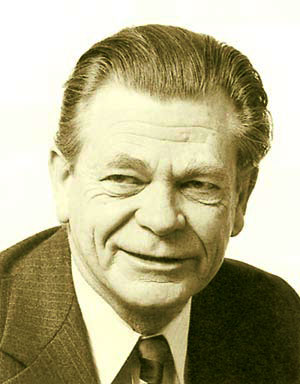
James McAuley
16
As late as 2006 (four hundred years later), in a newspaper review of the second-ever performance of composer Peter Sculthorpe’s opera ‘Captain Quiros’, McAuley’s poem was still being heralded by conservatives aspiring to honour a national historical “visionary”. In the same year, 2006, the Spanish government presented a memorial sculptural bust of Quiros to Australia. It stands on a pedestal outside the Department of Foreign Affairs in Canberra, the national capital.
17
Philip Mead reads McAuley’s poem as a component of the heroic and mythic Australian tradition, ‘Voyager’ poetry. Mead cites historical examples like an epic poem written in 1823 at Cambridge University by the bunyip aristocrat William Charles Wentworth, poems by John Dunmore Lang (written in situ on a ship), Rex Ingamells (a Jindyworobak), Vincent Buckley (also a Catholic) and others. He refers to poet Thomas Shapcott’s 1977 paper ‘Developments in the Voyager Tradition in Australian Verse’ that looks at the nationalising voyager writings of later poets like Grace Perry, Les Murray, Chris Wallace-Crabbe etc. Mead analyses McAuley’s poem’s political influence in spite of its actual failure as mythopoesis. Here, he incorporates the fervent mythologising in favour of de Quiros as Australia’s discoverer by Cardinal Moran, the late nineteenth century Archbishop of the Archdiocese of Sydney, and he extrapolates brilliantly on the topoi of the discoverers’ sea voyages and shipwrecks in the writings of many ‘Australian poets dreaming of an age or place more golden than their own.’
18
As Mead’s meticulous research tells us, it was McAuley’s academic position as a lecturer in Colonial Administration in Melbourne University’s Australian School of Pacific Administration, immediately after the second world war from 1946 and continuing until 1960 when he visited Papua New Guinea frequently, that directly connected him with that country’s formative institutions as it moved towards constitutional nationhood. Thus the de Quiros myth was destined for absorption and historicisation by none other than the indigenous founding leader of the PNG government, the current PNG prime minister Sir Michael Somare, who had a long interest in voyager narratives. Mead writes
19
The story of Quiros, as poetry though, seems able to provide him [Somare] with not just a narrative to navigate these dangerous social and political waters, but one that can speak for him and the nation constituted during his lifetime.
20
In 1964 Angus & Robertson published James McAuley’s poem in Sydney and the first House of Assembly opened in Papua New Guinea. Meanwhile, Australian poetry was shucking off the colonial past, absorbing ideas from the northern hemisphere (the UK, France and so on) and engaging energetically with dissent, ideologies and cultural influences from the US. Captain Quiros was about to be replaced by Captain Beefheart.
21
4. ‘Homelessness’, as Mead says ‘reads Judith Wright’s poetry against the grain of the critical reception of her work so far’.
22
Judith Wright was born, in 1915, into a ‘settler’ family in Armidale, on the New England Tableland in northern New South Wales. Family expectations then were that a girl would marry a grazier and carry on the tradition of pastoral farming. Not the case for Judith Wright. Philip Mead begins the essay
23
Judith Wright represents a unique instance, from twentieth-century Australian culture, of a creative life, albeit one that was characterised by contradictions and that continues to be uneven in its reception. While she was recognised as a major poet in the mainstream Australian tradition [from 1940 on]… and would probably still be regarded as ‘conservative’ in her poetics, Wright’s subsequent work, over a long lifetime., as a writer, as a woman intellectual, and as a political activist was frequently in contention with social norms in Australia, with the generally unchallenged rhetoric of a ‘White-imagined’ nation, and with the institutions of knowledge as she experienced them.
24
Judith Wright died at the age of 85, in June 2000, only ten days after she had joined the People’s Walk for Reconciliation across Commonwealth Bridge in Canberra. At the end of her life she was probably better known as a poet who was a nature conservationist and activist on behalf of indigenous people than she was for her actual poetry.
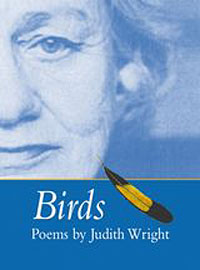
25
Wright was the first president and a founding member of the Wildlife Preservation Society of Queensland in 1963. In the 1960s and 70s she was active as both a writer and a negotiator in the campaign to establish the Great Barrier Reef Marine Park. In the mid-80s she was involved in the call for a treaty for Aboriginal people. In 1987 she returned her ‘Order of Australia’ award to the federal government in protest at the ongoing neglect and bad treatment of Aboriginal people in the face of preparations to celebrate the country’s coming bicentennial year. She was also active in the drawn-out, painful struggle that led to the Mabo indigenous land rights legislation in 1993.
26
But, as Philip Mead asks — ‘Where was poetry in all this?’ His stated interest is in ‘how to rethink, now, Wright’s poetry in relation to the alternating currents of her creative after-life.’
27
And, given that Wright was an oppositional thinker with paradox and conflict central to her poetry and philosophy, ‘alternating currents’ is a more than appropriate term. As he notes, ‘Uniquely, Wright contributed as powerfully to the critique of national culture as she did to its construction. Perhaps for the reason that her work was able to articulate this bi-polar politics of Australian white identity so uncompromisingly, it appears to be the object of forgetting in some cultural sectors. in a time of neonationalism, which seems to have produced a new rhetoric of disremembering, the ghost of Judith Wright is a seriously discomforting one.’ Wright represents both early settler memory and radical social thought. In her own words she knew ‘the love of the land we have invaded, and the guilt of the invasion’.
28
On a research visit to the National Library, in the bookshop Mead finds a collection of Wright’s poems about birds, illustrated in full-colour with drawings from the Library’s archive. It is packaged as a gift volume. He sees this as the poet having been reduced to ‘a fractional cultural space and that the repackaging her in this way makes her into ‘a strictly delimited poet of nature’. Her poetry relegated to the great gift idea shelf.
29
Judith Wright wrote diversely and voluminously — more than 20 books of poetry, historical and literary criticism, autobiography, conservation and Aboriginal studies essays as well as editing anthologies. In Brisbane in the 1940s she co-edited the influential national literary journal Meanjin. Critic John Carmody describes Wright’s friend, the late Queensland poet Val Vallis as having been ‘determined that she received full credit (which was commonly given to Clem Christesen) as founding spirit of Meanjin, who also did most of the work.’ She also wrote many reports, letters, articles and essays. My generation encountered Wright’s ‘South of My Days’, a 1946 poem that powerfully represents early twentieth century pioneers, being taught ‘heroically’ in the 1960’s high school English curriculum. Yet her early collection Woman to Man (1949), containing frankly sexual poems about love, relationship and childbirth, seems proto-second-wave feminist. The experiential notion of ‘human-ness connected with the world’ in Wright’s poetic trajectory is realised in the openly sentimental poem from 1973, ‘Two Dreamtimes’ where she gratefully addresses her close friend, the indigenous poet and activist, Kath Walker (who later reverted to her indigenous tribal name Oodgeroo Noonuccal). That poem has become, along with ‘At Cooloolah’ from 1955, one of her better known poems of reconciliation.
30
What has rendered this incredible body of work generally unavailable to contemporary readers? Mead speculates; was it her own waning interest in poetry at the same period of the death of her philosopher husband, Jack McKinney, and her coincidental increasing commitment to environmental and social justice causes? ‘Was it entirely explicable in terms of the socio-economics of publishing and a shifting regime of cultural values that had simply discounted Wright’s multiform contribution as a writer?’
31
Judith Wright’s ‘after-life’ is represented by the naming of a Brisbane cultural centre and the instigation of a small biennial cultural festival in her honour (in the district where she spent her final years) — but, again,
32
Where was poetry in all this?
33
Mead posits ‘that we haven’t understood Wright as capaciously as we might’. He finds contexts for her work within the current stream of ‘decolonising thought’ in Australia that might begin the task of redressing the neglect of her rich intellectual complexities. He cites international poeticists like Jed Rasula, Terrence Diggory and Peter Middleton as models of theoretical poetry criticism as he urges that we ‘forge our own such critical discourse, according to the structures, productions and histories of our own cultural fields’.
34
In the last impressive section of ‘Homelessness’ Mead puts this urging into immediate practice as he writes on Wright’s evolving humanism in the face of the world intellectual crisis in the post war years and through the 1960s after the atomic bomb explosions — what McKinney and Wright called the ‘modern crisis’.
35
At the same time that Judith Wright, her husband Jack McKinney and their tiny scene of literati were immersed in the ‘modern crisis’, they were unaware that the Europeans, Sartre and Heidegger, were too. Mead uses Heidegger’s ‘Letter on Humanism’ (not yet translated from German in 1947) to draw parallels with Wright’s thinking.
36
Among many others [1] he brings Gaston Bachelard’s Poetics of Space, Deborah Bird Rose’s theory of entwined social and ecological justice and Val Plumwood’s deep ecology ideas into play, to reveal Wright’s developing uncertainties about the ‘idea of habitation’. Wright and McKinney often read and worked outside the house. In fact, McKinney was living in a tent when they first met. Mead analyses Wright’s poem ‘Habitat’ which aims ‘to establish a myth of the “shared house” of Australia’ thus highlighting the intractable Australian problem of settlement, ownership and indigenous land rights — — hence Mead’s essay’s title. Judith Wright called her final poetry collection Phantom Dwelling.
37
5. ‘It’s poetry Jim, but not as we know it!’is about the inventive use of new technologies to make poetic texts. Basically Mead engages here with the combination of
38
… ‘human-only language’ and electronic (computer) languages to generate and manipulate poetic texts. It does so by way of the analogy of analogue to digital. Digital poetry, as opposed to the old analogue paradigm, works with an idea of the translatory, combinatory and permutatory possibilities of language.
39
Information technology, personal computers and widespread global use of the internet has altered the writing and publication of poetry inexorably and has manifested a networked language. ‘Networked language produces networked selves that exist within networked culture.’
40
A paradox of this aspect of contemporary poetics is the way in which poets are experimenting with the electronic generation and manipulation of texts at exactly the moment that ‘poetry’ seems to be precisely the use of language, at least in non-mainstream traditions, that most resists commodification. E-poetries are flourishing in the same space as the poetry of counter-globalisation.
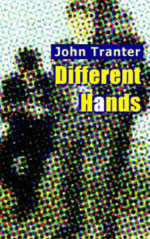
41
Mead uses Australian poet and editor John Tranter’s 1998 collection of computer-generated texts, Different Hands, to investigate this ‘new’ media’s effects on cultural history. Using a textual-analysis computer program called ‘Brekdown’ Tranter combined, for example, Allen Ginsberg’s ‘Howl’ with sections from a Bobbsey twins story, then Gertrude Stein and William Gibson, then E.M. Forster and advertisements from Sydney real estate, and so on, to concoct stories via the program which reads text as patterns of letters and punctuation. Meaning is absent from this kind of text so, ingeniously, Tranter then brought the texts back from nonsense into comprehensible, if unsettling, stories. [3]
42
Mead says
43
This essay, then, is a kind of sim called ‘Postmodernity in Australia’ and is designed to be run as a representation, or model, of an impossibly complex historical and textual system.
44
6. Unsettling language returns to ‘human-only language’ and analyses the poetry of the indigenous activist Lionel Fogarty and Macedonian-Australian performance and written poet ΠΟ (pron: “pie oh”, the pen-name of Peter Oustabasidis) regarding contemporary multiculturalism. Both Fogarty and ΠΟ are ignored by the canonising and national-identity-questing literary institutions in Australia and we realise through reading their poetry just how monolingual Australia is.
45
In the introduction to New and Selected Poems : Munaldjali, Mutuerjaraera (1995) Lionel Fogarty says
46
To Aboriginal people in my country, listening and hearing is more important than reading materials. The whole magical way of song and dance is difficult to write down very well, because poetry is emotion. Only a black writer can produce the authenticity in it.
47
In my writing I don’t believe in compromise at all. I don’t want to be a reconciliation writer or a reformist writer. I like to hit psychological minds and cross boundaries. It doesn’t matter if it is in correct grammar or their style of writing, because the white man will always criticise written pieces of paper.
48
White man will never really fully interpret what a black man is thinking when he is writing. Maybe in generations to come this may change.
49
Australian literature, its culture and history inextricably bound to early-colonial settlement and its obsession with a self-conscious determination to develop a defined national literary tradition, has begun to change in the fourteen years since Fogarty wrote that introduction. Mead writes
50
Preoccupied with its own belatedness, our national literature has been reluctant to realise its own neo-colonialist assumptions and the ways in which the thematics of white belonging — ‘nation, landscape, the literature of the soil’ — belong to the ‘toxic legacy of colonialism’. [2] Now, as the pressures of neo-liberal economics and globalisation are reshaping contemporary culture, the literary paradigm that played a central role in underpinning Australian settlement is breaking up. One effect of this break-up is to allow us to recognise more clearly the kind of poetries that best support [a] previous model of a national Australian literature, and those that don’t.
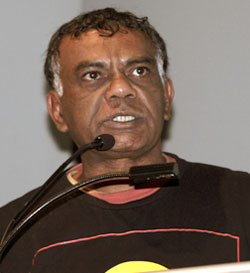
Lionel Fogarty, Melbourne, 2008, copyright Jodie Ranger © 2008.
51
Mead wants to place the neglected topic of contemporary postcolonial poetries as a significant and necessary contribution to new literary-critical paradigms in Australia. These non-conformist poetries are made within ‘the hugely diverse networks of contemporary Australian language, including dialects of English, Aboriginal English, indigenous literary modes, ‘migrant’ English, language maintenance and revival, Kriol, and emergent versions of Australian English, and ethnolects — mongrelized lingos of all kinds. These networks of language and culture are hardly ever acknowledged in the narrowed range of official Austlit as it is represented and institutionalised in modes of research, publishing and teaching.’
52
In Mead’s view, poetry like Fogarty’s and ΠΟ’s, ‘is, in fact, an index of the linguistic repression at the heart of recent attempts to discuss, publicly, Australian identity.’ He sees the attempts at a national cultural discourse as having been ‘shut down’ during the eleven long years of monocultural government, from 1996 until 2007, led by the monolingual prime minister John Winston Howard. (In fact, Howard was so obviously monomaniacal that Alan Moir, the cartoonist for the daily newspaper The Sydney Morning Herald, always depicted him as monocular, as having only one eye.) This period included a continuing iteration of national heroics manifested in the increased celebration of past wars, and a consolidation of national myth and settlement history. Anyone dissenting from this view or expressing remorse in remembering the massacres and dispossession of indigenous peoples, or worse, expecting some kind of apology; was said to be inventing ‘black armband’ history; was always in mourning, or limping for sympathy, rather than looking towards an imaginary, supposedly utterly secure and fixed future, where an uncomplicated white history is completely assured. No room in that future for unconventional languages like Fogarty’s or ΠΟ’s.
53
Mead discusses received English in the post-colonial world as a language that ‘has not been innocently or apolitically ‘received.’
54
This reception has in fact, a troubled and divided history. Official or ‘national’ language, with its powerful networks of insitutionalisation, is one of the primary means by which nation-states seek to overcome the turbulence of cultural diversity and the profound social differences represented by community languages.
55
Mead questions the state-indemnified notion of a ‘singular Australian language’ using Fogarty and ΠΟ as two small samples, of aberrant poetry that diverges from this norm, and he does so from a context of knowledge of the ‘whole tradition of poetry in Australia, like the one that James McAuley so deliberately wished to establish and maintain ‘ one that would ‘in [Mikhail M.] Bakhtin’s words… accomplish “the task of cultural, national and political centralization of the verbal-ideological world.”’
56
Both Fogarty and ΠΟ deliberately disregard conventional English. (The last sentence, on the back page of 24 Hours, is ‘Fuck the spelling.’). Their work offers alternatives to normative ways of poetic thinking and reading. Here is the title poem, ‘What Saying Says’ from Minyung Woolah Binnung, Lionel Fogarty’s 2004 collection of poems and drawings —
57
What saying
says
same as laying bout
race as taken us
ace as lag
us
pace as sagged us
The still distillery owned
Reliving
our black future
is of most greatest to a eye
But the Abo
playwriter said
he bro’s you not listens
to
noboby not even your
own kind
The sun shone at a cold
night’s air
The half moan came over the
body is laying on the frosted
grassed plains
Now the
laughter at hate
Laughter at TV crap
Laugh
at my world reefed for
a leaving sign
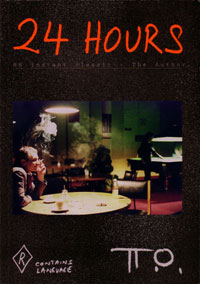
58
Mead uses ΠΟ’s 740 page poem 24 Hours to demonstrate how linguistic hybridity can produce democratic poetry. The poem attempts to embody the everyday life and language of an urban migrant community in Fitzroy in inner Melbourne. The poem is set, mostly, on the street — in coffee shops, milk bars, a pool hall, outside government housing flats and other public spaces. The speakers reflect the community, consisting of Greek, Italian, Albanian, Maltese, Lebanese, Vietnamese, Turkish, German, Aborigines, Yugoslav, Chinese, Bulgarian and some ‘Australians’ (meaning Anglo-Celtic). In part, the poet’s function is like that of an audio recorder, and he is concerned here with synthesising human-only languages. The poem is written in English in a heard-vernacular combining the sounds of varietal accents. ΠΟ also uses punctuation and other symbols from a qwerty keyboard to visually represent oral/aural sequences.
59
The -Sky-
. . .
. . . . . . . . rumbles (again), and
the
“rain”
drops out of the sky, like a bag of
“bolts”
“./)@!-[=+*^<
bouncing
around in a bucket
60
The poetic writings of Lionel Fogarty and ΠΟ, although differing in scope, ethnicity, race and intention, are nonetheless both instances of ambitious broad projects that are relegated to the margins of official Australian poetic culture. Projects that Philip Mead says
61
… imagine through, and in, language an alternative polis, a poetic space where the diversities of politics and identity, including their own, are able to be articulated and represented. It is hardly surprising that these poetic projects should be marginalised; they are difficult to listen to. They represent an intolerable challenge to a mainstream Australian identity, with all its political and social investments. But any (critical) talking cure for the linguistic disorders that the Australian settlement suffers from, might begin by listening to such poetic language. Especially if we have any interest in the cultural future of Australia.
[1] Shirley Walker, Jennifer Strauss, Meaghan Morris, Jennifer Jones, Peter Read, Hugh Stretton, Robin Boyd, Charles Altieri, Patricia Dobrez, David Carter, Kay Ferres, Andrew Ross and Plato
[2] A.L. McCann, ‘The Literature of Extinction’, Meanjin, 65; 1 ; pp54 (2006)
[3] You can read an article on the Brekdown program in Jacket 4: http://jacketmagazine.com/04/rubenking.html
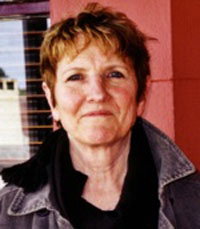
Pam Brown
Pam Brown’s most recent collection of poetry is True Thoughts, published by Salt Modern Poets in 2008. Another title, Authentic Local, is forthcoming from Papertiger Media in June 2009. She is Jacket magazine’s associate editor.